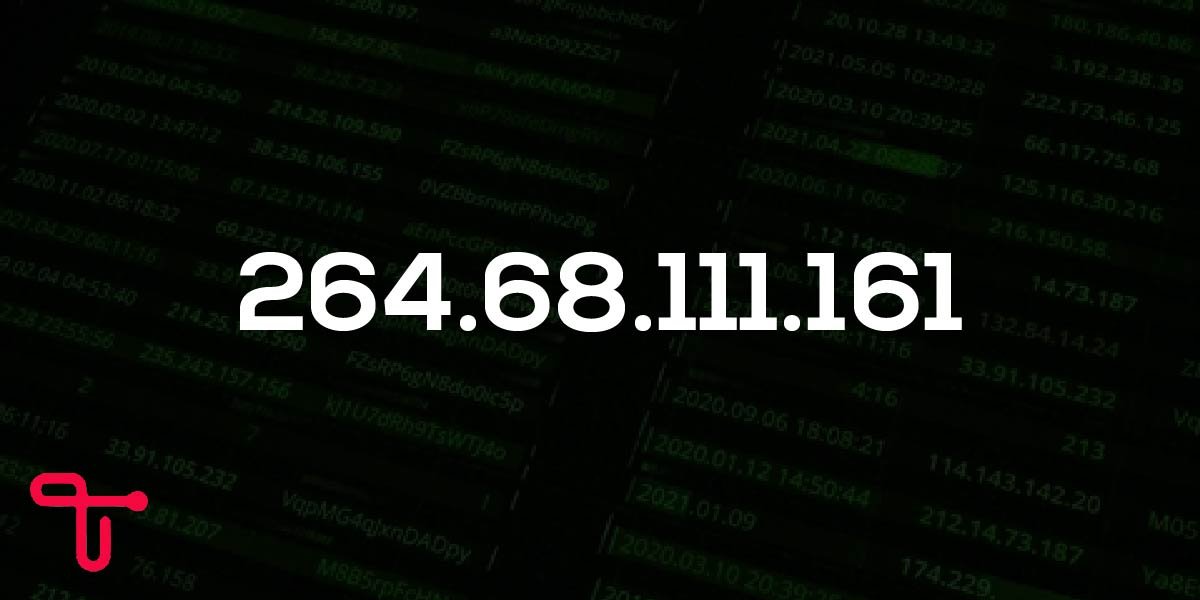Technology
264.68.111.161: Unraveling the Mystery Behind the Invalid IP Address

Introduction
In the vast and interconnected landscape of digital communication, Internet Protocol (IP) addresses play a crucial role as unique identifiers that facilitate the exchange of information across the internet. However, not all IP addresses you may come across are valid or conform to established standards. An intriguing example of such an anomaly is “264.68.111.161”. This address stands out because it does not adhere to the typical formatting rules of IP addresses. In this article, we explore the nature, implications, and the insightful lessons we can learn from examining “264.68.111.161”, an ostensibly standard IP address that is, in fact, invalid.
Understanding IP Addresses
Basics of IP Addressing
IP addresses are fundamental to network communication, serving as unique identifiers that allow devices to connect and communicate over the internet. Whether it’s browsing a website, sending an email, or streaming a video, every device requires an IP address to interact online. IP addresses come in two main versions: IPv4 and IPv6.
Structure of IPv4 Addresses
IPv4, the most common form of IP addresses, consists of four octets—each ranging from 0 to 255. This range is due to each octet being an 8-bit binary number. Therefore, the total range for each segment should not exceed 255. This structure allows over four billion unique combinations, which, although vast, has necessitated the development of IPv6 due to the exhaustion of available IPv4 addresses.
The Anomaly of 264.68.111.161
Analyzing the IP Address
“264.68.111.161” appears at first glance to be a regular IPv4 address but reveals its irregularity upon closer inspection. The first octet, “264”, exceeds the maximum limit of 255, making it invalid within the IPv4 addressing scheme. This peculiarity makes “264.68.111.161” a prime candidate for discussions about IP address validations and errors.
Common Misinterpretations and Errors
Anomalies like “264.68.111.161” can arise from various sources, such as typographical errors during data entry or system misconfigurations. These errors can often lead to connectivity issues or confusion in network settings, highlighting the importance of accurate IP address configuration.
Technical Implications of Invalid IP Addresses
Network and Connectivity Issues
Using an invalid IP address like “264.68.111.161” can lead to significant network and connectivity issues. Devices may fail to connect to the network, and administrators might spend considerable time troubleshooting non-existent faults due to incorrect address entries.
Security Risks
Invalid IP addresses can also pose security risks. For instance, they can be used in IP spoofing attacks where malicious parties use altered IP addresses to trick systems into thinking they are interacting with trustworthy entities. Understanding and preventing these types of vulnerabilities is crucial for maintaining network security.
IP Address Management and Best Practices
Best Practices in IP Address Validation
Validating IP addresses is essential in network setups to avoid the problems associated with invalid addresses. Network engineers and IT professionals use various tools and techniques to validate and verify IP configurations to ensure all addresses are within the acceptable range.
Preventing Common IP-Related Errors
To prevent errors related to IP misconfigurations, organizations implement stringent validation rules and utilize automated tools to detect and correct erroneous entries. This practice helps maintain the integrity and reliability of network communications.
Future of IP Addressing
Transition from IPv4 to IPv6
The transition from IPv4 to IPv6 is driven by the need for more IP addresses than IPv4 can offer. IPv6 addresses use 128 bits, significantly increasing the number of possible addresses and supporting the continuous growth of the internet.
The Role of AI and Advanced Technologies
Advanced technologies like AI are increasingly being integrated into network management and security. These technologies can predict potential network failures, detect unusual patterns, and offer proactive security measures to mitigate risks.
Conclusion
The discussion surrounding “264.68.111.161” sheds light on the critical aspects of IP addressing, including the importance of valid configurations and the potential consequences of errors. By examining this invalid IP address, we gain deeper insights into both the technical and practical dimensions of network management. As we move forward, the role of accurate IP management continues to grow, underscoring the need for vigilance and advanced technology in overseeing digital communications.
FAQs About 264.68.111.161
What is an IP address and why is “264.68.111.161” considered invalid?
An IP address is a numerical label assigned to each device connected to a computer network that uses the Internet Protocol for communication. The IP address “264.68.111.161” is considered invalid because the first octet, 264, exceeds the maximum allowable value of 255 for an IPv4 address. IPv4 addresses must consist of four octets, each ranging from 0 to 255.
Can an invalid IP address like “264.68.111.161” be used in network settings?
No, an invalid IP address like “264.68.111.161” cannot be used in practical network settings because it does not conform to the IPv4 protocol standards. Using such an IP address would lead to configuration errors and connectivity issues within a network.
What are the potential risks of accidentally using an invalid IP address in network configurations?
Using an invalid IP address can lead to several issues, including network communication failures, system errors, and troubleshooting complexities. It may also cause security protocols to fail, exposing the network to potential security threats or enabling IP spoofing attacks.
How can I ensure that IP addresses in my network are valid?
To ensure that all IP addresses are valid in your network, employ IP address validation tools and software that check for adherence to the IP formatting rules. Regular audits and reviews of network configurations can also help catch and correct any erroneous entries before they cause issues.
What steps can be taken to prevent typographical errors in IP address entries?
To prevent typographical errors when entering IP addresses, consider implementing form validation in your software that automatically checks the validity of IP addresses as they are entered. Training staff on the correct format and common mistakes can also reduce errors. Additionally, using configuration management tools that automate IP address assignments can help eliminate manual entry errors altogether.
Read More: Jusziaromntixretos: Revolutionizing Interdisciplinary Innovation
For More News And Stories, Visit Tech In Style

-

 Blog5 months ago
Blog5 months ago鲁Q 669FD: Unveiling Shandong’s Mysterious License Plate
-

 Technology5 months ago
Technology5 months agoIs Zupfadtazak Dangerous? An In-Depth Analysis
-

 Technology5 months ago
Technology5 months agoUnderstanding SSIS 469 Errors: Causes, Solutions, and Best Practices
-

 Life Style5 months ago
Life Style5 months agoChef Gotxen Godolix: A Culinary Innovator Transforming Gastronomy